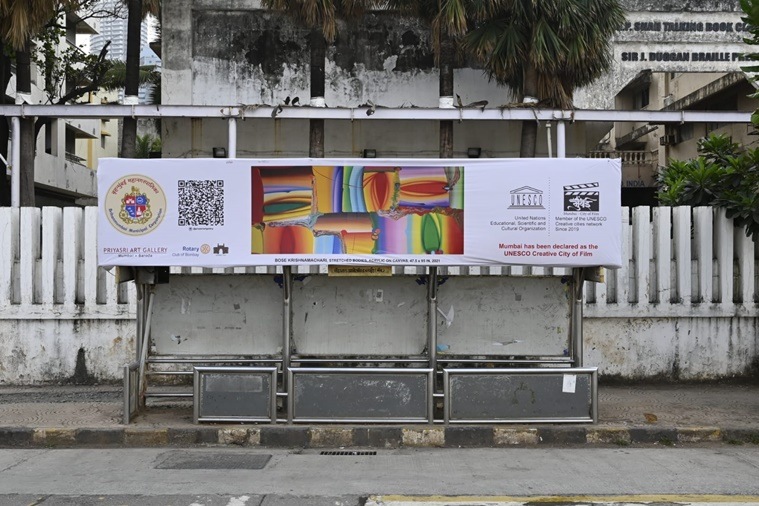Mumbai was recently conferred with the designation of UNESCO Creative Film City. As such, to spread awareness and widen the scope of visual art’s viewership, 15 bus shelters between Mumbai’s Mantralaya to Worli sea-face to Nariman Point have been turned into alternative art spaces featuring works of 15 established and young artists whose lives have been carved in the city.
The exhibiting artists include Al-Qawi Nanavati, Baiju Parthan, Bose Krishnamachari, Brinda Miller, Chirodeep Chaudhuri, Meera Devidayal, Nayanaa Kanodia, Nuru Karim, Priyanka D’souza, Sooni Taraporevala, Sunil Padwal, T V Santhosh, Tanya Singh, Teja Gavankar, Vikram Bawa.

The force behind the initiative — Mumbai Billboard-Bus Shelter — is Priyasri Patodia, art facilitator and founder of Priyasri Art Gallery, in collaboration with MCGM (Municipal Corporation of Greater Mumbai) and the Urban Heritage Committee of Rotary Club of Bombay (RCB) .
Story continues below this ad
Interestingly, one can also scan a QR code on the bus shelters and “take the art home”. “This QR code is linked to a space where the information about the artist along with images of the work can be accessed. The idea is to connect with the youth. One just has to trigger their interest because music, art, and culture is in the DNA of every human, especially if you are Indian,” said Priyasri.
 Priyasri Patodia’s talks about her new venture. (Source: PR Handout)
Priyasri Patodia’s talks about her new venture. (Source: PR Handout)
In an exclusive interaction with indianexpress.com, Priyasri talked about Mumbai’s global recognition in the art space, and the city’s thriving art scene, while sharing details about the pilot project.
What does the UNESCO Creative City of Film tag mean for Mumbai?
Bestowing Mumbai with a prestigious honour is indeed a big achievement! This award is a tribute to every Mumbaikar, who tirelessly propels the city forward each day. It is something that needs to be communicated to Mumbaikars and Indians. They are known for their indestructible and unflinching courage. Mumbai is the way it is because of the Mumbaikars.
What can you tell us about the initiative?
Story continues below this ad
The public art installation is a way of interacting with every Mumbaikar on the street, and will hopefully reinforce their indestructible, never giving up spirit. It actually sheds light upon several opportunities. Firstly, at a time of gloom and doom, any positive message that is communicated creatively can help people have a change of mind and encourage them to think positively. Secondly, we intend to use art and culture to effectively communicate this message. Mumbaikars have persevered through various trials, including the current pandemic, but they have never given up fighting for peace, harmony, and joy. In a way, the current calamity has indirectly buttressed the ‘many in body, one in mind’ spirit of the city dwellers.
Also, every artist needs feedback on their work, and viewership brings feedback. With the shutting down of galleries during the pandemic, we decided to bring art to virtual spaces. Getting art to a public domain is just an extension of this.
Why bus shelters?
I wanted to do something for the sanitation workers who have been on the frontline. They have done an equal amount of work, especially with biomedical waste during the coronavirus pandemic. I strived to display reproduced artworks of artists, whose lives have been shaped by the city of Mumbai. It all started when I was working with the Smile Foundation (SF). I, along with an incubator of SF and the BMC (Brihanmumbai Municipal Corporation), came up with the idea of paying a tribute to sanitation workers. The Municipal Corporation of Greater Mumbai (MCGM)’s Shashi Bala encouraged me and assured their support. I suggested a public art installation and strived to announce this subtly. We were trying to get some sponsors but it was challenging during the Covid-19 pandemic.
Story continues below this ad
 Artist Bose Krishnamachari’s artwork at Mumbai’s National Association for Blind (Source: Priyasri Patodia)
Artist Bose Krishnamachari’s artwork at Mumbai’s National Association for Blind (Source: Priyasri Patodia)
In the midst of this roadblock, I took guidance from Ishan Raina, ex-founder, Chairman of Havas Advertising and Media in India along with our own ex-President Ramesh Narayan for using billboards for displaying artworks.
One of them suggested the idea of using bus shelters that looked very dull during the pandemic, as our canvas. The BMC was excited when I approached them with this idea. Since they own the BEST bus shelters, they could give these spaces for a period of a month to communicate these important and uplifting messages as their contribution to the cause. They asked me to narrow it down to 15 bus shelters, which were quickly assigned to us.
What are your views alternative art spaces?
I believe that as Indians, art has always been in our DNA. It is foolish to think that only a limited segment of the intellectual audience is interested in art. People are trying to make ends meet, they do have pressure, but it doesn’t limit them from admiring art. Therefore, I believe that alternative spaces of art have always existed in the form of monuments, cinema, theatre etc. With the project, we thought why not bring art out of the white cube galleries and make it more accessible in the public domain? I always feel that there is a poetic spirit in every human being. With the lockdown gradual opening up, these billboards may serve as rejuvenating social elements in these parched times.
 Artist Teja Gavankar’s artwork at Nehru-Tarangan, Mumbai. (Source: Priyasri Patodia)
Artist Teja Gavankar’s artwork at Nehru-Tarangan, Mumbai. (Source: Priyasri Patodia)
Why do you think there is a need to take art behind cubicles?
Story continues below this ad
Art in Mumbai has various formats ranging from commemorative sculptures to iconic murals on the façade of eminent buildings of the business district. Though the public engagements with art have enhanced in recent years, viewing, and experiencing art remains to be a niche affair for the laymen. Making contemporary art accessible would be possible if the art is brought in the domain of daily commuters.
Ranging from Ashoka Stupa to Ajanta Caves and paintings of Raja Ravi Verma, art always thrived with patrons and initiated the inclusion of the common man. They also built monuments as an extension of art, for the public.
How powerful are public art installations?
History proves that art and culture have aided in restoring peace and stability in the society. A public installation may or may not affect the common man, but again when you are exposing them to this activity, this again comes in the warp and weft of a person. I do understand that for an average Mumbaikar it is about survival, but who says that they can’t have a few moments of solace by indulging in music, art, poetry, cinema? All these elements of recreation can help a person take away from reality for a while and de-stress them.
The strength of Mumbai’s industriousness lies in its working class that remains to be connected with art considering they are immersed in their formidable duty of running the city tirelessly.
Story continues below this ad
How were the works chosen?
We see Mumbai as a city of dreams and wanted to include artists whose lives were carved by the city of Mumbai. Their struggles resonate with every Mumbaikar’s life. We did select from a variety of art forms ranging from contemporary to realistic. There are some artists who paint the mundane life of a Mumbaikar, some who are involved in Kala Ghoda.
 Artist Nayanaa Kanodia’s art displayed at Mumbai’s Jaslok Hospital. (Source: Priyasri Patodia)
Artist Nayanaa Kanodia’s art displayed at Mumbai’s Jaslok Hospital. (Source: Priyasri Patodia)
The pandemic claimed and cost the people of Mumbai with their vigour and industrious spirit. The project envisages revitalising the creative spirit of the city. But definitely, we should acknowledge the pandemic and the never-giving spirit and hope for a better tomorrow.
How would you describe the response?
The response has been truly humbling, and there is a sea of emotions that the artworks have evoked in the people. The award is for every Mumbaikar as they create the city’s vibe and culture. It is a commemoration to Mumbaikars who have celebrated life amidst all the difficulties.
Story continues below this ad
📣 For more lifestyle news, follow us on Instagram | Twitter | Facebook and don’t miss out on the latest updates!



 Priyasri Patodia’s talks about her new venture. (Source: PR Handout)
Priyasri Patodia’s talks about her new venture. (Source: PR Handout) Artist Bose Krishnamachari’s artwork at Mumbai’s National Association for Blind (Source: Priyasri Patodia)
Artist Bose Krishnamachari’s artwork at Mumbai’s National Association for Blind (Source: Priyasri Patodia) Artist Teja Gavankar’s artwork at Nehru-Tarangan, Mumbai. (Source: Priyasri Patodia)
Artist Teja Gavankar’s artwork at Nehru-Tarangan, Mumbai. (Source: Priyasri Patodia) Artist Nayanaa Kanodia’s art displayed at Mumbai’s Jaslok Hospital. (Source: Priyasri Patodia)
Artist Nayanaa Kanodia’s art displayed at Mumbai’s Jaslok Hospital. (Source: Priyasri Patodia)

























